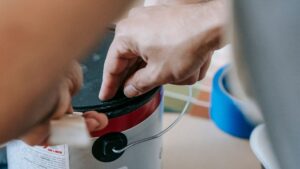When it comes to art, experimentation knows no bounds. Have you ever considered using wall paint on canvas for your next temporary or experimental project? Let’s dive into this intriguing idea that might just ignite your creativity.
What is Wall Paint?
Wall paint, often known as house paint, is a versatile medium primarily used for painting interior or exterior walls. It comes in various finishes like matte, eggshell, satin, or gloss and offers a wide spectrum of colors.
Canvas as Your Experimental Ground
Canvas, typically associated with traditional acrylic or oil paints, can be an unexpected canvas for wall paint. While it’s not the conventional choice, it presents exciting opportunities for temporary or experimental artwork.
Advantages of Using Wall Paint on Canvas
- Affordability and Accessibility: Wall paint is relatively affordable and accessible, available in numerous colors and finishes at local hardware stores.
- Texture and Consistency: Some wall paints have unique textures and consistencies, adding depth and character to your artwork.
- Temporary Nature: As an artist exploring new techniques or ideas, using wall paint on canvas allows you to create without the permanence of traditional art materials.

A Man Opening A Can Of Paint
Tips for Experimenting
- Surface Preparation: Ensure the canvas is primed or prepared to handle the wall paint. Experiment with different primers for varied effects.
- Testing and Mixing: Explore the paint’s behavior on canvas through small test patches. Mix colors to create unique tones and shades.
- Tools and Techniques: Use various brushes, rollers, or even unconventional tools to apply the paint and experiment with textures.
So,….
Experimentation is at the heart of artistry. Embrace the unconventional by using wall paint on canvas for your temporary or experimental projects. It’s a cost-effective, versatile, and exciting avenue to explore, offering unique textures and opportunities for innovation. Remember, art knows no boundaries let your creativity flow.
Embracing Creativity: Steps for Using Wall Paint on Canvas
Now that we’ve piqued your interest in utilizing wall paint for your experimental art, let’s delve deeper into the steps and considerations for your creative journey.
Step-by-Step Guide
1. Gathering Supplies
Collect your materials:
- Canvas
- Wall paint in desired colors and finishes
- Primers or gesso for surface preparation
- Brushes, rollers, or other painting tools
2. Preparing the Canvas
- Ensure your canvas is clean and free from dust or debris.
- Apply a primer or gesso suitable for wall paint adherence. Experiment with different primers for varied textures.
3. Testing and Mixing
- Create a small test area on the canvas to observe how the wall paint behaves. Experiment with color mixing and blending techniques.
- Explore different consistencies and textures the paint can offer on the canvas.
4. Paint Application
- Use various tools to apply the wall paint on the canvas. Brushes, rollers, sponges, or even your fingers can create diverse textures and effects.
- Layer the paint to create depth and dimension in your artwork.
5. Exploring Techniques
- Experiment with techniques like splattering, sponging, or scraping to add unique elements to your artwork.
- Play with contrasts, tones, and shapes to express your creativity.
Tips for Success
- Work in Layers: Allow each layer to dry before adding another to prevent smudging or mixing of colors.
- Venture Beyond: Don’t restrict yourself to traditional brushstrokes. Explore unconventional methods and tools for application.
- Embrace Imperfections: Art is about expression. Embrace imperfections and unexpected outcomes as part of your creative process.
Conclusion
The fusion of wall paint and canvas presents an unconventional yet thrilling avenue for artistic exploration. Don’t be afraid to push boundaries, experiment with techniques, and let your creativity flow onto the canvas.
Remember, the beauty of temporary art lies in its impermanence, allowing you to fearlessly experiment and evolve as an artist. So, pick up your brushes, embrace the unconventional, and embark on your wall paint canvas adventure today.
Comparison tabular
| Aspect | Acrylic/Oil Paint on Canvas | Wall Paint on Canvas |
|---|---|---|
| Purpose | Permanent artwork | Temporary or experimental projects |
| Medium | Specifically formulated for art | Primarily designed for wall surfaces |
| Cost | Art-grade paints can be pricey | Generally more affordable |
| Color Range | Extensive range available | Wide array of colors and finishes |
| Texture | Smooth and consistent | Varied textures and consistencies |
| Drying Time | Faster drying time | Longer drying time on canvas |
| Versatility | Adaptable to various techniques | Unique textures and effects possible |
| Permanence | Offers lasting, archival quality | Not intended for long-term display |
| Artistic Freedom | Allows precise detailing | Encourages experimentation |
This table can serve as a quick reference, outlining the main differences between these painting methods on canvas.
Final words
In the realm of art, exploration knows no bounds. Whether you opt for the tried-and-true acrylics or oils on canvas or dare to venture into the realm of temporary artistry with wall paint, the canvas becomes your playground.
Traditional mediums offer permanence and precision, ideal for creating lasting masterpieces. Conversely, using wall paint on canvas opens doors to experimentation, inviting you to play with textures, colors, and unconventional techniques, all in the name of temporary expression.
Remember, each stroke on the canvas tells a story. Whether you seek permanence or embrace the impermanence of your creations, your journey as an artist is a tapestry of experiences and expressions.
So, pick up your brush, whether laden with art-grade paints or dipped in wall paint, and let your creativity flow. Embrace the unexpected, celebrate imperfections, and paint your world with the colors of innovation and expression.
Your canvas awaits a blank slate, eager for your artistic footprint. Embrace the canvas, embrace the paint, and above all, embrace the joy of creation.

For over a decade, I’ve been Mike, an artist, crafter, and designer deeply immersed in the Croc world. I thrive on crafting unique, size-inclusive patterns, fostering creativity, and sharing them on ktforum.com. My designs aim to ignite your creative spark and delight you, ensuring clarity and ease of use through rigorous testing. Join me in expressing your creative flair and showcasing your craft with joy.
Related Posts
- Exploring Alternatives to Wall Paint for Canvas Art
When it comes to creating stunning canvas art, wall paint isn't the only option in…
- Exploring the Cost of Wall Paint for Canvas Art: A Comparative Analysis
When diving into the world of painting, choosing the right type of paint can significantly…
- Preserving Your Canvas Art: Understanding Wall Paint and Fading
Painting on canvas offers a beautiful, expressive way to create art. But when it comes…
- Using Wall Paint on Canvas for Children’s Art Projects: A Colorful Exploration
When it comes to fostering creativity in kids, art projects are an incredible way to…

